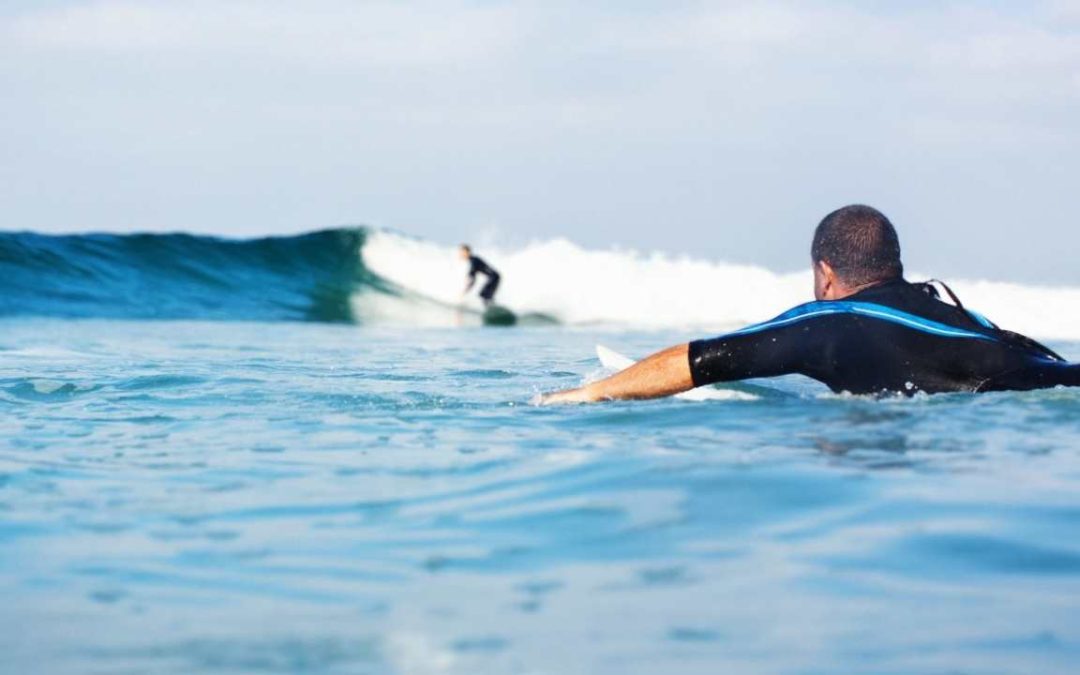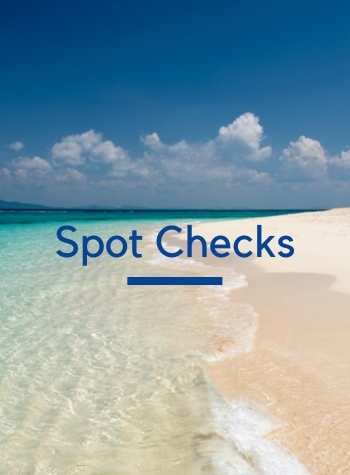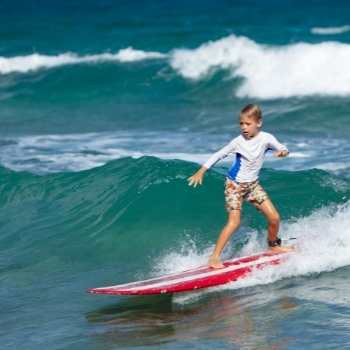From balancing on a board to reading waves, surfing is not an easy sport to master. But what most newbies to the sport quickly realize, itʻs not the act of riding waves where most people struggle, itʻs with all of the paddlings.
And itʻs not just beginners that have a tough time with it. Experienced surfers who donʻt get as much water time as they used to tend to have trouble keeping their paddling stamina up.
Paddling and positioning can account for as much as 80% of your surf session, so doesnʻt it make sense to be the best paddler you can be?
Iʻve been lucky enough to surf for over 30 years of my life. In that time, Iʻd have stretches where Iʻve surfed multiple times a day to maybe only a couple of times per month.
What has always stayed the same is my commitment to keeping up my paddling stamina. Without it, surfing is near impossible. This post is based on those 30 years of experience. Let it help you improve your paddling ability next time you paddle out.
Best Thing You Can Do To Improve Your Paddling…Go Surfing
This should go without saying. The best way to improve your paddling is by surfing. No other activity will give you the same results that paddling out for a surf will give you.
That time of my life when I surfed 3 times a day…I felt like I could paddle for days. No other cross training needed.
I donʻt know about you, but itʻs pretty easy to convince myself to keep paddling for more as long as thereʻs a another decent wave to be caught. Ask me to swim 5 laps in a pool, though, and Iʻm watching the clock the entire time.
Try to paddle out for a surf at least 3 times per week for best results.
Not only are you training your paddling muscles by going surfing, you are also gaining more experience in the surf zone that canʻt be had with other forms of training.
If you find it difficult to get past the breaking waves and out into the lineup, you may need a little more guidance. Check out this article on How To Paddle Back Out, it will help you understand ways to make it easier to get back out into the lineup.
Like with any other form of training, understanding fundamentals is the key to ensure long term success. So letʻs go over the fundamentals of paddling a surfboard.
Fundamentals of Paddling A Surfboard
Positioning On The Board Is Key
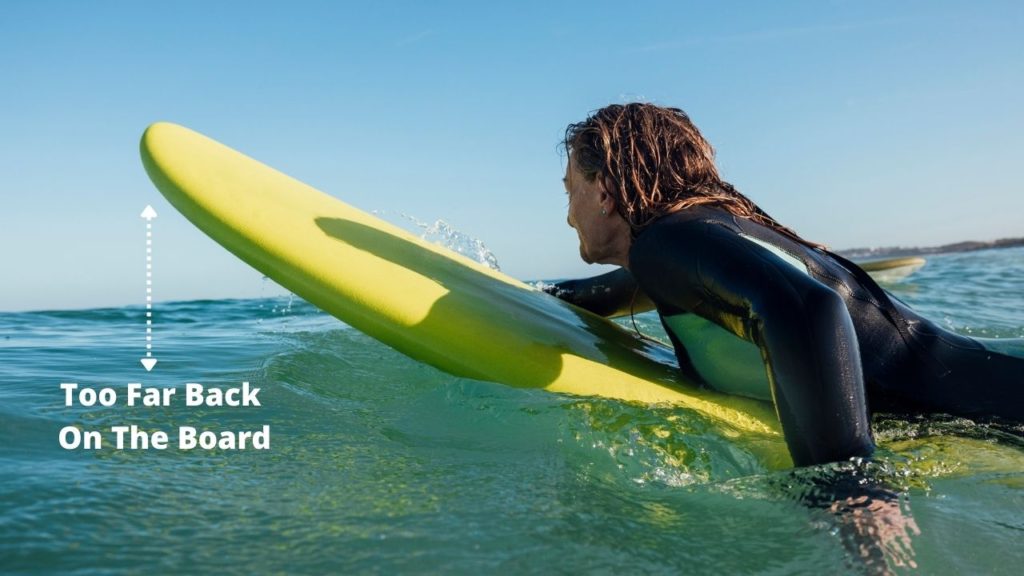
I often see this problem with beginning surfers. Paddling a surfboard is hard for them because they do not have proper body positioning on their surfboard.
You want to place your body right in the sweet spot on your board, where the nose of the board glides just above the surface of the water. Too far forward on your board and the nose will be underwater, too far back and the nose of your surfboard is lifted too far out of the water slowing you down.
Where exactly you position yourself depends on your size and the size of your board. Youʻll know you are in the right spot when the nose of your board is just a few inches out of the water without it going under the water surface.
Find yourself properly balanced on your board and you will find yourself effortlessly gliding through the water.
Keep Your Head Up
This is another issue I see beginners have when they are paddling their surfboards. All too often, their heads are lying on their board while paddling, only looking up for a brief moment to see where they are going.
This makes paddling a surfboard even harder.
You will want to have head up, shoulders off of your board, with your body resting on your sternum instead of your chest, similar to a cobra pose in Yoga.
This may be difficult for those of you just starting out, but lucky for you, iʻve included a few exercises below that you can do from home that should help make this easier for you.
Long Strokes with Arms
Being efficient with your paddling strokes will make you a better paddler. Too often I see beginners use short paddling strokes that expend more energy than needed.
Alternating arms, keep your fingers together forming a large paddle with your hands, pierce the water with your fingertips as far up towards the nose of your board as you can and pull back towards the tail. Your arm should make a “S” like movement as it travels from the nose to the tail of your board.
Also, keep your feet up. You donʻt want to be dragging them behind you like anchors while your arms are struggling to pull you out to the lineup.
Do this in a regular rhythm and you will be paddling like a pro in no time.
3 Things You Can Do While Surfing To Increase Your Paddling Speed
While 80% of your time surfing is spent paddling, you may as well work on specific aspects of it during your surf session to become even better at it. Here are 3 exercises I do while surfing that switches up my paddling and makes me stronger in the process.
- Speed Bursts
When paddling back out after catching a wave, alternate your paddling speed; 10 second speed burst, 10 second normal paddling, repeat until you are back in the lineup. This will prepare you for the burst of power you need while paddling for waves. - The Wave Hog
For the most part, I like to wait out the back for waves. But on occasion, I like to paddle around on the inside, constantly moving, picking off any wave that goes unridden. I can do this constant paddle, catch wave, paddle for about an hour before I get too tired.
It is one of the best ways to build paddling stamina while catching a lot more waves in the process. Just make sure you donʻt snake anyone. - The Paddle Battle
When paddling back out, pretend you are in competition with another surfer to see who will get back into the lineup first and establish priority.
Itʻs pretty simple, paddle back out to the lineup as hard and as fast as you can, no breaks. Not only will your paddling speed increase, but youʻll be putting yourself in the position to catch more waves.
Cross-Training Can Help Improve Your Paddling Stamina
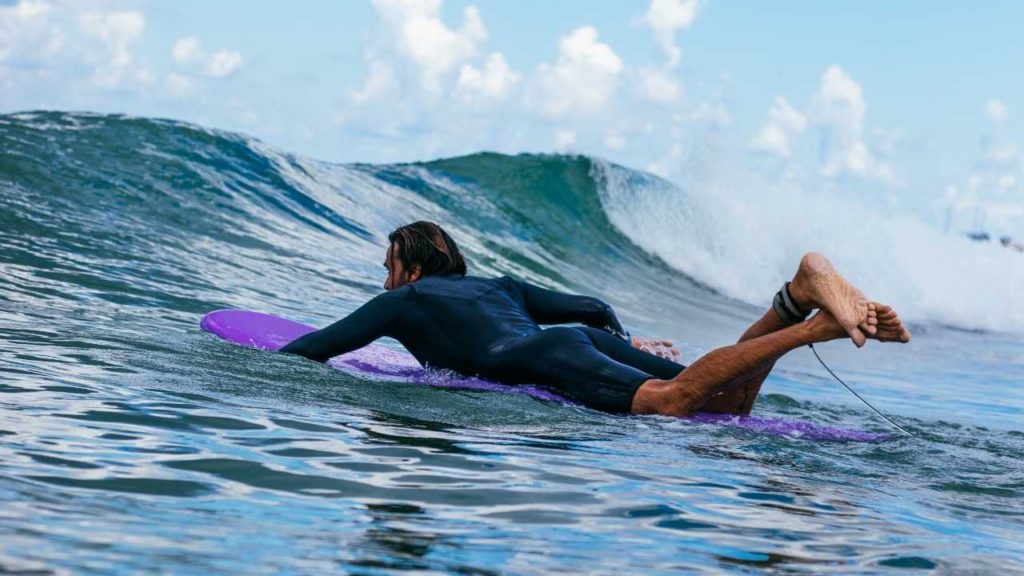
For whatever reason, itʻs not always possible to paddle out for a surf, but that doesnʻt mean you canʻt improve your paddling. Cross training can deliver great results when it comes to improving your overall paddling speed and stamina.
Running
When I was a kid, if the surf wasnʻt good, I was running. I would run on the sand between lifeguard towers or just go for a quick jog outside my house down to the local park and back. Nothing much, maybe 20 or 30 minutes or so.
By running, you increase your lung capacity and stamina, making any other physical exercise that much easier.
Itʻs harder now that Iʻm older to find time for a run, but between wasted time scrolling on facebook or binge watching Netflix, there surely are a few minutes somewhere that you can dedicate to improving yourself.
Bicycling
If you donʻt like running, riding a bike may be just the thing for you. Bicycling is another great way to improve your overall cardiovascular health while also strengthening your legs in the process.
I love riding my bike when I have a destination, so pick a spot out that you like to head off to and make that your end point. While riding, alternate between speed bursts and normal riding speeds. This will get your heart pumping, lungs breathing and kick your stamina into overdrive.
If you find yourself a little landlocked, this is a great way to train without having to be in the water.
SUP
While I donʻt believe that Stand Upʻs belong in the lineup, I do believe in the ability of a SUP to help improve your paddling ability, just keep it in flat water.
I like to train on an SUP the same way I do with paddling, by engaging in speed bursts and racing drills. Itʻs easy to just slowly sweep the water away and glide lazily across the water surface, but incorporate some drills and you will find those paddling muscles burning in no time.
Kayak
This is one of my favorite forms of cross training, especially when you combine it with fishing. Paddling a kayak works many of the same muscles as paddling a surfboard.
I have a kayak with a fishing pole holder. I get my selfed geared for trolling (dragging a lure behind me while paddling) and head on out.
I can paddle for hours if there is a hope that I might catch a fish, itʻs much more exciting that way and Iʻm more likely to do it.
By alternating my paddling speed I also get to improve my chances of hooking up a fish, so I get to crosstrain while hopefully bringing home food for the dinner table. Your significant other will be much more likely to be onboard with this option.
Paddling
There is nothing that can improve your paddling more than by paddling. When the waves are flat, Iʻll take out my longboard and go for a long paddle.
If you have a buoy to swim to, swim to that. If you are paddling at a beachbreak, paddle between lifeguard towers. Find a landmark and paddle to it. Switch up your speed now and then and watch your paddling skills level up in no time.
Swimming
If you canʻt paddle, but have access to a pool, youʻre in luck. A pool is a great way to train for paddling. In fact, some companies have even created specially designed paddle boards that can be used in a pool for the sole purpose of allowing surfers to work on their paddling.
If you want to learn more about paddle training in a pool, then be sure to check out this article in which we dive deeper into creating a pool workout that delivers results.
(check out this article about paddle training in a pool)
10 Exercises You Can Do At Home To Improve Your Paddling Strength
Now Iʻm no fitness coach, Iʻve just been surfing for over 30 years. Lucky for us, there are others out there that have made this their living. And thank god for that!
I donʻt get in the water as much as Iʻve used to these days, having a family and a job that limits my time in the water, but Iʻve been able to keep up on my fitness (kind of) by taking part in a fitness program by Surf Strength Coach. Without them, I wouldnʻt last more than half an hour out there.
Iʻm sharing a few paddling exercises you can do at home here in this post, but it in no way makes up for the comprehensive program put together by Chris Mills at Surf Strength Coach. If you want to take your surf fitness to the next level, I highly recommend their 12 week, Surf Athlete Training Program.
11 Home Exercises To Improve Your Paddling
- Arm Circles
With both arms spread open to your sides forming a “t” with your body, start with your left arm and do full body circle motions for 30 seconds. Alternate to your right arm for another 30 seconds. Go right into the next exercise. - Arm push forward, pull back
With both arms spread open to your sides forming a “t” with your body, open your hands so the palm faces the front of the room. Push your arm in small, pulsing movements towards the front of the room for 30 seconds.
Turn your palms around toward the back of the room and pull your arms in small pulsing movements toward the back of the room for 30 seconds. Go right into the next exercise. - Arm Lifts
With both arms spread open to your sides forming a “t” with your body, start with your palms facing down towards the floor and lift your arm in small pulsing movements towards the sky for 30 seconds.
Switch so your palms are facing up towards the sky and once again make small pulsing movements towards the sky for another 30 seconds. Your arms should be burning now. - Push Ups
Give yourself a 15 second rest and go right into a set of pushups for 1 minute. You can do conventional pushups, have your knees on the ground, propped up on a bench, itʻs up to you. Just do slow, controlled pushups bringing your body down just above the ground and then push back up. - Tricep Dips
Find a bench that you can use to perform tricep dips for 1 minute. Pretend you are about to sit on the bench, but instead of sitting, hold onto it with your arms behind you and dip down, engaging your tricep muscles in the back of your upper arms. Keep your knees bent to make this move easier or straighten them for more difficulty. - Alternating One Arm Side Plank
Position your body into the plank position on your hands. Lift your right arm and twist your upper body to side plank position with your left arm holding you up and your right arm pointing to the sky. Lower your right arm back to the ground and repeat on the other side. Do this for 1 minute. - Superman
Laying on your stomach, extend your arms out straight and lift your upper torso and legs so that they are off the ground. You should look like superman flying through the air. Hold this position for 1 minute or alternate arm/leg movements by pulsing them up towards the sky for a deeper workout. - Forearm Plank
Laying on your stomach, rise up to a push up position and lower down onto your forearms. Stay in this plank position for 1 minute, keeping your core engaged throughout the entire exercise. - Arm Circles
Going back to our first 3 exercises, with both arms spread open to your sides forming a “t” with your body, start with your left arm and do full body circle motions for 30 seconds. Alternate to your right arm for another 30 seconds.
Your arms should be burning now. Donʻt give up and lower your arms. Go right into the next exercise. - Arm push forward, pull back
With both arms spread open to your sides forming a “t” with your body, open your hands so the palm faces the front of the room. Push your arm in small, pulsing movements towards the front of the room for 30 seconds.
Turn your palms around toward the back of the room and pull your arms in small pulsing movements toward the back of the room for 30 seconds. Go right into the next exercise. - Arm Lifts
With both arms spread open to your sides forming a “t” with your body, start with your palms facing down towards the floor and lift your arm in small pulsing movements towards the sky for 30 seconds.
Switch so your palms are facing up towards the sky and once again make small pulsing movements towards the sky for another 30 seconds.
Finished!! Your arms should be on fire!
Stretching Makes Paddling A Whole Lot Easier
When it comes to paddling, flexibility is just as important has having strong muscles. Not only do you need a full range of motion in your shoulders, but a flexible back is important as well.
Once again, I highly suggest the Surf Strength Coach Flexibility program to get your body limbered up and ready for surfing. The program has done wonders for my surfing, especially as my body ages and my joints get a little more creaky.
So why donʻt we let Chris Mills of Surf Strength Coach guide you through 3 stretches for your shoulders that can really help make your paddling a whole lot easier.

